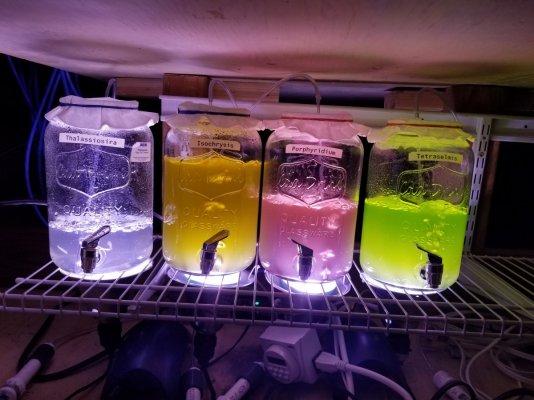- Joined
- Aug 7, 2017
- Messages
- 2,685
- Reaction score
- 3,900
Well HELLO neighbor!! we are down in Redwood City.
Follow along with the video below to see how to install our site as a web app on your home screen.
Note: This feature may not be available in some browsers.
Well HELLO neighbor!! we are down in Redwood City.
Hiya!Well HELLO neighbor!! we are down in Redwood City.
Thanks for the info. Where/what was your source of pods? How's the upkeep on the cultures, pretty simple I hope?Guillard's f/2 is a fertilizer specifically designed for culturing phytoplankton. I get mine from floridaaquafarms.com but there are lots of places that sell it.
For about a year I cultured large quantities of nannochloropsis, isochrysis (T-iso) and tetraselmis. I also have tried out Thalassorira and Porphyridium in smaller batches but was trying to set up continuous cultures and they crashed after a couple months. It looked pretty cool for a little while (see attached pic).
In my experience, tetraselmis is the easiest and most reliable. I know everyone says nanno is the easiest but that has not been my experience. The tet I used in this experiment was started from a 250ml starter left in my fridge for at least a year. I put it into a 5 gallon bucket and it started right back up. Try that with nanno (I have - it did not work out)... Which also leads to the primary reason I used tetraselmis for this - it's the only strain I currently have on hand because none of my other starters were viable. So... yeah I might try starting up some others again but would have to buy them so right now all I have to work with is tetraselmis. But this strain I have seems to be practically bulletproof so I figured it would be the best option anyway.

For pods I used Algagen for tisbe and apocyclops and and Reef Nutrition for Tig pods. I know algae barn also sells some pods and I recommend them in general although I've never bought pods from there. They are all abit pricey but after you get a culture started it should last a long time (potential of indefinitely).Thanks for the info. Where/what was your source of pods? How's the upkeep on the cultures, pretty simple I hope?
That looks delicious, can I have a double shot of that green stuff! Mmmmm....Guillard's f/2 is a fertilizer specifically designed for culturing phytoplankton. I get mine from floridaaquafarms.com but there are lots of places that sell it.
For about a year I cultured large quantities of nannochloropsis, isochrysis (T-iso) and tetraselmis. I also have tried out Thalassorira and Porphyridium in smaller batches but was trying to set up continuous cultures and they crashed after a couple months. It looked pretty cool for a little while (see attached pic).
In my experience, tetraselmis is the easiest and most reliable. I know everyone says nanno is the easiest but that has not been my experience. The tet I used in this experiment was started from a 250ml starter left in my fridge for at least a year. I put it into a 5 gallon bucket and it started right back up. Try that with nanno (I have - it did not work out)... Which also leads to the primary reason I used tetraselmis for this - it's the only strain I currently have on hand because none of my other starters were viable. So... yeah I might try starting up some others again but would have to buy them so right now all I have to work with is tetraselmis. But this strain I have seems to be practically bulletproof so I figured it would be the best option anyway.

